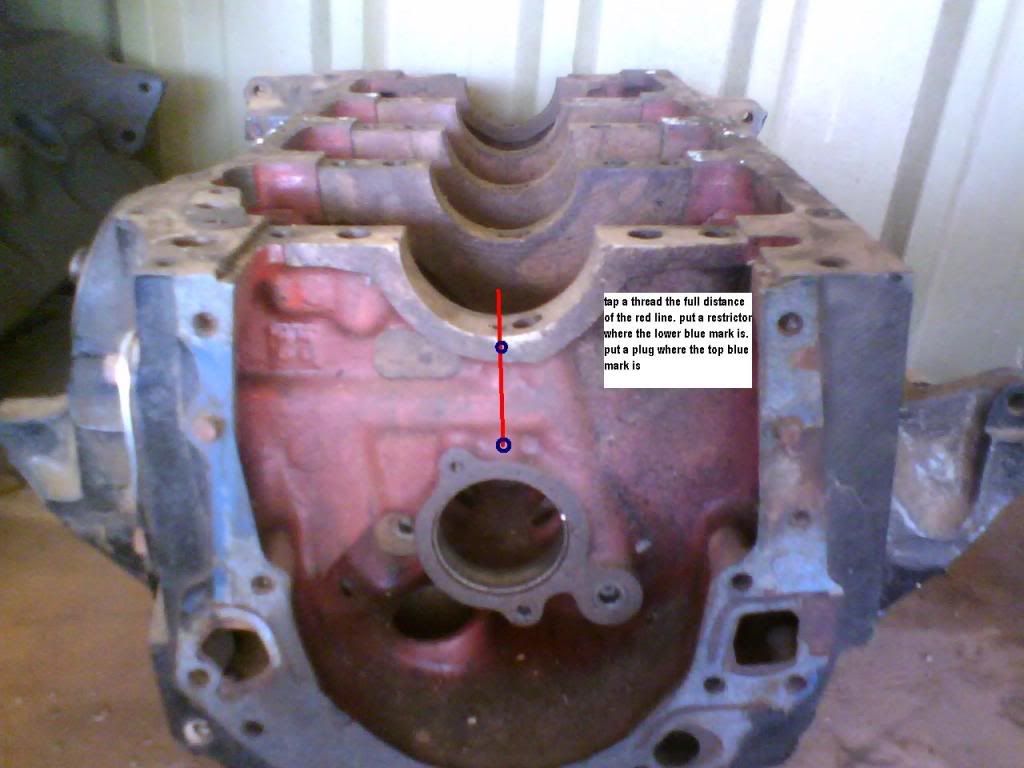quote:
Originally posted by captaintobeys:
This is why today's restrictor plug kits (including the referenced Moroso kit) now have only four small restrictors for the main saddles.
The Hot Rod Magazine explanation is backwards.
The original practice was to install small restrictors for cam bearings 2 through 5, a large restrictor for the left hand oil passage, and 8 tappet bore bushings for the right hand tappet bores. The bushings were only recommended for solid tappets. The new practice is to install small restrictors for all 5 cam bearings, the large restrictor is no longer used, and bushings are installed in all 16 tappet bores. They are recommended regardless of which type of tappet is being used.
The Moroso kit never had 5 small restrictors, it has always had only 4 small restrictors. The number of restrictors in the kit has never changed. The old practice was to use 4, the current recommendation is to use 5. The kit originally contained 4 restrictors for two reasons:
(1) Installation of the restrictor at the #1 saddle is a bit more complicated than the other 4.
(2) Folks didn't believe it was necessary because the configuration of the oil passages makes it seem as though the #1 cam bearing passage would not rob oil from the #1 main bearing.
Lubrication of connecting rods 2 through 7, which are supplied by main bearings 2, 3 and 4 are the problem areas. Lubrication of the #1 connecting rod, via the #1 main bearing, has never been a problem; BUT the #1 cam bearing passage DOES divert a significant amount of oil away from the main passage thus impacting lubrication downstream.
Experience has proven that installation of the restrictor for the #1 cam bearing improves the performance of the lubrication system significantly without any negative effects in terms of timing chain & distributor gear lubrication. The small restrictors in the Moroso kit have 0.060" orifices in them. A tremendous amount of oil flows out of an 0.060" restriction. Nothing is being under-lubricated.
Note: unless a restrictor for the #1 cam bearing is installed we haven't completely converted the 351C lubrication system to a "main priority" system.
In terms of the big restrictor, it was traditionally used at the #5 main saddle to limit oil supplied to all 8 of the tappets on the left hand side of the engine block. It was used in conjunction with 8 tappet bore bushings for the right hand tappets. That practice has been abandoned. The big restrictor is not recommended for any installation. It has been superseded by the use of tappet bore bushings for all 16 tappet bores. There are at least five benefits to this change:
(1) 16 tappet bore bushings insure a consistent amount of oil is supplied to all 16 valves, where it lubricates the rocker arm fulcrums and cools the valve springs (i.e. consistency of valve train lubrication).
(2) It prevents excessive oil flowing to waste at all 16 tappet bores.
(3) It alleviates tappet incompatibility issues for all 16 tappet bores.
(4) If hydraulic tappets are being used, it insures optimal performance of all 16 hydraulic tappets (i.e. consistency of valve train operation).
(5) If any of the 16 tappets pops-out of their bore lubrication of the rotating assembly will not be impacted.
I've never liked the idea of the big restrictor. In order to insure consistency of valve train operation & lubrication at all 16 valves I installed bushings in all 16 tappet bores even back in the 1970s & 1980s. My father-in-law was a machinist, he made the bushings for me, they only cost me the price of the round stock to make them ... and some beers and steaks. This practice came in handy. After installing a solid tappet cam (and 16 tappet bore bushings) in my first 351C I decided I didn't like the drivability and I went back to a hydraulic tappet cam. Nobody I knew of had ever gone back to using hydraulic tappets after installing bushings. But I had no valve train issues using the Johnson HT900 hydraulic tappets with the tappet bore bushings (which had 0.060" orifices in them). I've always believed that success was due in part to the fact the engine block had tappet bore bushings in all 16 bores instead of just the 8 on the right hand side.
-G


